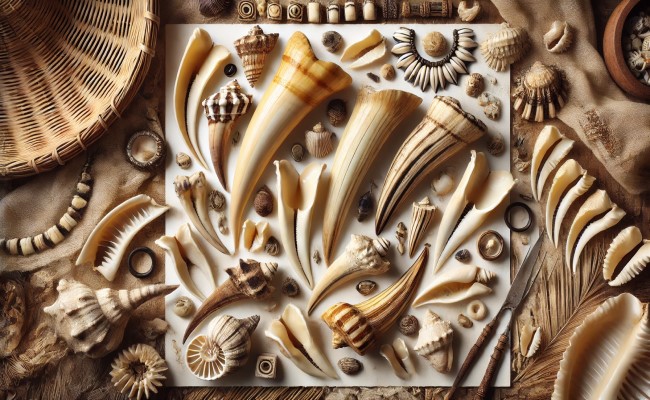Dentalium Shells: A Journey Through History, Craft, and Cultural Significance

Dentalium shells, small, tusk-shaped mollusks, have held significant value across various cultures for thousands of years. Known for their use as currency, jewelry, and ceremonial items, these shells have traveled vast distances through trade networks, symbolizing wealth, status, and spiritual importance. This article explores the origins, harvesting methods, and cultural significance of dentalium shells, delving into their use in crafting exquisite necklaces and other adornments. Additionally, we will uncover the alternative names for dentalium shells and their enduring legacy in indigenous cultures.
What is a Dentalium Shell?
Dentalium shells are marine mollusks belonging to the Scaphopoda class, commonly referred to as tusk shells or tooth shells due to their elongated, slightly curved shape resembling an elephant’s tusk. The most prized species, Antalis pretiosa (formerly Dentalium pretiosum), is found in the deep waters off the Pacific Northwest coast of North America. These shells have a unique tubular structure, with one end open and the other closed, allowing the animal to burrow into the seabed.
Where Do Dentalium Shells Come From?
The primary source of dentalium shells is the coastal waters around Vancouver Island, Canada, particularly the regions inhabited by the Nuu-chah-nulth and Kwakwaka’wakw peoples. These indigenous communities have long been the stewards of dentalium harvesting, with rights to specific marine areas where the shells are found. The shells were not only abundant in these regions but were also of exceptional quality, making them highly sought after in trade.
How Are Dentalium Shells Harvested?
Harvesting dentalium shells is a skill passed down through generations, requiring knowledge of the sea and the shells’ behavior. Traditionally, indigenous peoples used specially designed tools, such as long poles with brushes attached to the ends, to reach the shell beds on the ocean floor. These poles were pushed into the seabed, ensnaring the dentalium shells, which were then carefully retrieved. The process was labor-intensive and required precise timing, as the best shells were found in deeper waters, often several hundred feet below the surface.
In recent times, the harvesting of dentalium shells has continued, with some adaptations in technique but still adhering to traditional practices. The shells are collected, cleaned, and sorted based on size and quality, with the longest and most intact shells being the most valuable.
Dentalium Shell Necklace: A Symbol of Wealth and Craftsmanship
Dentalium shell necklaces have been a symbol of wealth, status, and craftsmanship in various indigenous cultures, particularly among the tribes of the Pacific Northwest and Northern California. These necklaces were often part of ceremonial attire, worn by high-status individuals during important events and rituals. The length and quality of the shells used in the necklace determined its value, with longer, unbroken shells being particularly prized.
Crafting a dentalium shell necklace is an art form that requires skill and patience. The shells are carefully strung together, often with additional beads or ornaments made from materials like glass, bone, or other shells. The design of the necklace can vary greatly, reflecting the cultural significance and personal style of the wearer. In some cultures, dentalium shell necklaces were also used as a form of currency, with the length of the necklace determining its monetary value.
The Cultural Significance of Dentalium Shells
Dentalium shells have held deep cultural significance for many indigenous communities, particularly in the Pacific Northwest, Northern California, and the Great Plains. They were often used in ceremonial attire, including headdresses, necklaces, and other adornments. In some cultures, the shells were incorporated into bridal jewelry, symbolizing purity and status. The shells were also used in funerary rites, included in burials as a sign of respect and to ensure the deceased’s journey to the afterlife.
The Yurok, Karuk, and Hupa tribes of Northern California held dentalium shells in high regard, using them not only in personal adornment but also as a form of currency. The shells were often stored in elk-antler purses or treasure baskets, passed down through generations as family heirlooms. Among these tribes, dentalium shells were also used in gambling and commerce, with the shells’ length and quality determining their value.
What is Another Name for Dentalium?
Dentalium shells are also commonly referred to as “tusk shells” or “tooth shells,” names derived from their distinctive shape. In some indigenous languages, they are known by specific terms that reflect their cultural importance. For example, the Nuu-chah-nulth people of Vancouver Island refer to the shells as “hiixwa” or “haqua,” highlighting their role in trade and adornment.
The Role of Dentalium Shells in Trade Networks
These shells were a crucial part of trade networks that spanned vast regions, from the Pacific Northwest to the Great Plains and beyond. These shells were traded for a variety of goods, including food, dyes, hides, and other decorative materials. The shells’ value as a trade item was so significant that they were often used as a form of currency, with specific lengths of dentalium shells corresponding to set values.
The trade of dentalium shells was not limited to North America. Evidence suggests that dentalium shells were also used in trade networks in the ancient Levant, where they were included in ritual burials. Although the exact significance of the shells in these burials remains unclear, their inclusion indicates their value in ancient societies.
Modern Use and Revival of Dentalium Shells
Today, dentalium shell continue to hold cultural significance, particularly among Native American and Inuit communities. The revival of traditional arts and crafts has led to a renewed interest in using dentalium shells in jewelry, regalia, and other decorative items. These shells are still harvested and traded, maintaining their value as a symbol of cultural heritage and craftsmanship.
The use of dentalium shells in modern crafts often incorporates both traditional and contemporary elements, reflecting the dynamic nature of indigenous cultures. Whether used in elaborate necklaces, earrings, or ceremonial regalia, dentalium shells remain a powerful symbol of identity and continuity.
Conclusion
Dentalium shells, with their rich history and deep cultural significance, continue to be cherished in many indigenous communities. From their origins in the deep waters off Vancouver Island to their role in trade networks and ceremonial life, these shells have traveled vast distances and connected diverse cultures. Whether crafted into intricate necklaces or used as a form of currency, dentalium shells embody a legacy of wealth, status, and tradition that endures to this day.
As we continue to explore the cultural significance of dentalium shells, it is essential to recognize and honor the traditions that have preserved these remarkable artifacts for generations. Through the continued use and appreciation of dentalium shells, indigenous communities maintain a vital connection to their heritage, ensuring that the legacy of these beautiful mollusks remains alive for future generations.

